MXA RACE TEST: THE REAL TEST OF THE GASGAS EX 350F CROSS-COUNTRY
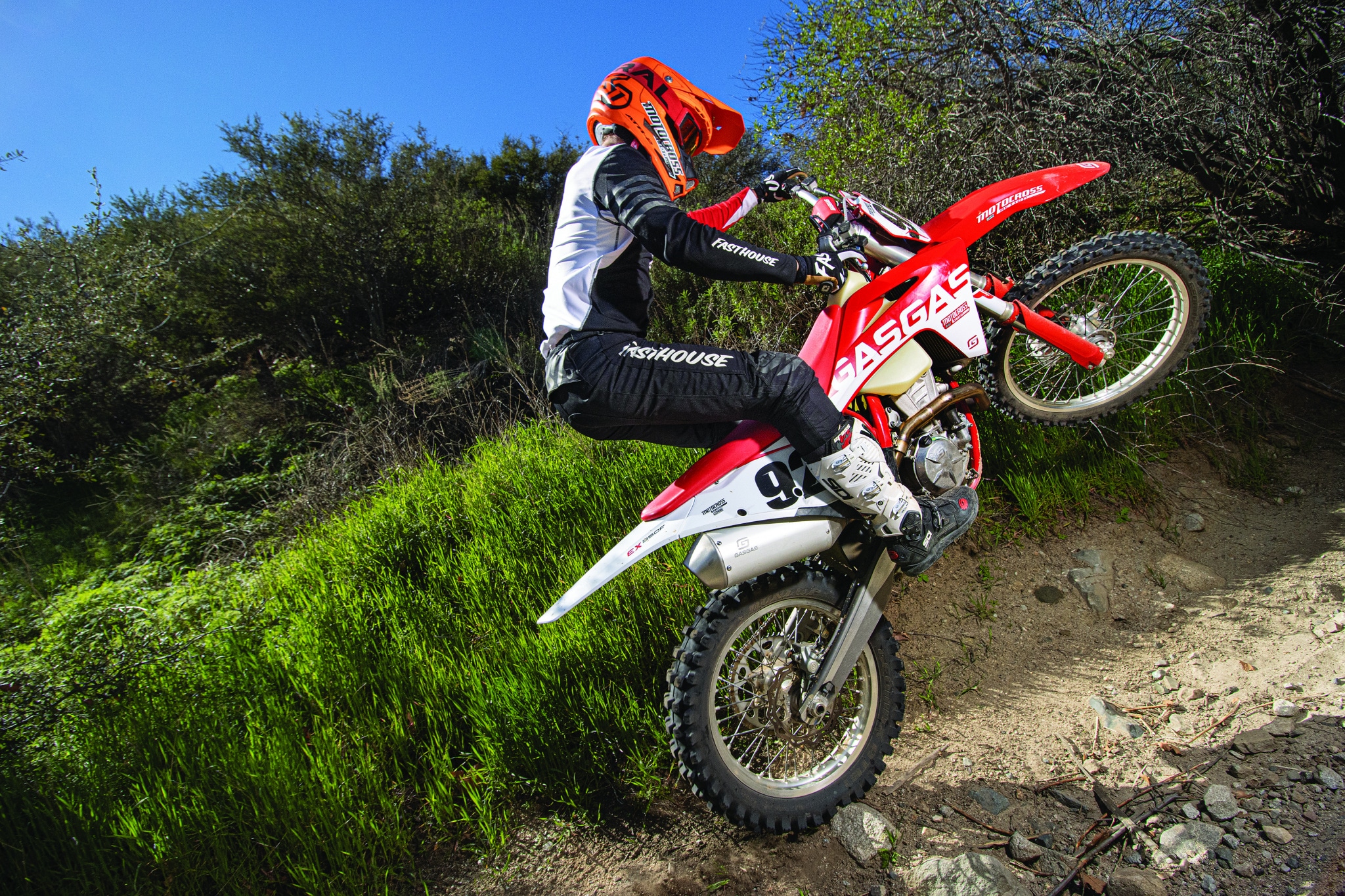 THE GEAR: Jersey: Fasthouse Raven, Pants: Fasthouse Raven, Helmet: 6D ATR-2, Goggles: Viral Brand Comp, Boots: Sidi Crossfire 3SR.
THE GEAR: Jersey: Fasthouse Raven, Pants: Fasthouse Raven, Helmet: 6D ATR-2, Goggles: Viral Brand Comp, Boots: Sidi Crossfire 3SR.
Q: FIRST AND FOREMOST, IS THE 2021 GASGAS EX 350F BETTER THAN THE 2020 GASGAS EX 350F?
A: No, for one obvious reason, which will become evident when you read further.
Q: WHAT IS A 2021 GASGAS EX 350F? WHAT WAS IT BUILT FOR?
A: Over the last few years, enduro bikes have been broken into two different breeds—enduro and cross-country. Take KTM as an example. KTM makes EXC models for enduro and XCF models for cross-country. Husqvarna makes FE models for enduro and FX models for cross-country. Yamaha, Kawasaki, Suzuki and Honda don’t make any purebred enduro models, but they offer cross-country models of various displacements. And, more to the point, GasGas makes an EC 300 two-stroke for enduro and EX 250F, EX 350F and EX 450F four-strokes for cross-country racing.
A cross-country bike is a hybrid machine that is best suited to high-speed cross-country events but is 90 percent based on the brand’s motocross bike. For example, a Yamaha YZ250FX cross-country bike is a YZ250F motocross bike but with a six-speed transmission, 18-inch rear wheel, O-ring chain, gas gauge and kickstand. As conceived, cross-country bikes are trying to be all things to all people.
 The head pipe doesn’t have the KTM and Husky resonance chamber, but those are mostly used for sound, not power.
The head pipe doesn’t have the KTM and Husky resonance chamber, but those are mostly used for sound, not power.
Q: IS THE 2021 GASGAS EX 350F AN OFF-ROAD VERSION OF THE 2021 MC 350F MOTOCROSS BIKE?
A: No. The 2021 GasGas EX 350F differs from most cross-country bikes in that it isn’t a modified version of the GasGas MC 350F motocross model. Why not? Because GasGas didn’t make a 2021 MC 350F motocross model. Its closest relative is the 2021 KTM 350XCF cross-country bike with which it shares its cross-country roots.
Why is the GasGas EX 350F a kissin’ cousin to the KTM 350EXC? Because of platform sharing. Platform sharing is when a manufacturer uses major components from one brand as the basis for another. In this case, the GasGas EX 350F borrows the engine, frame, suspension, wheels and brakes from the KTM 350XCF. Platform sharing saves money, because instead of having to build new frames and engines for each brand, the manufacturer can enjoy the benefits of sharing the same parts across several different models or brands.
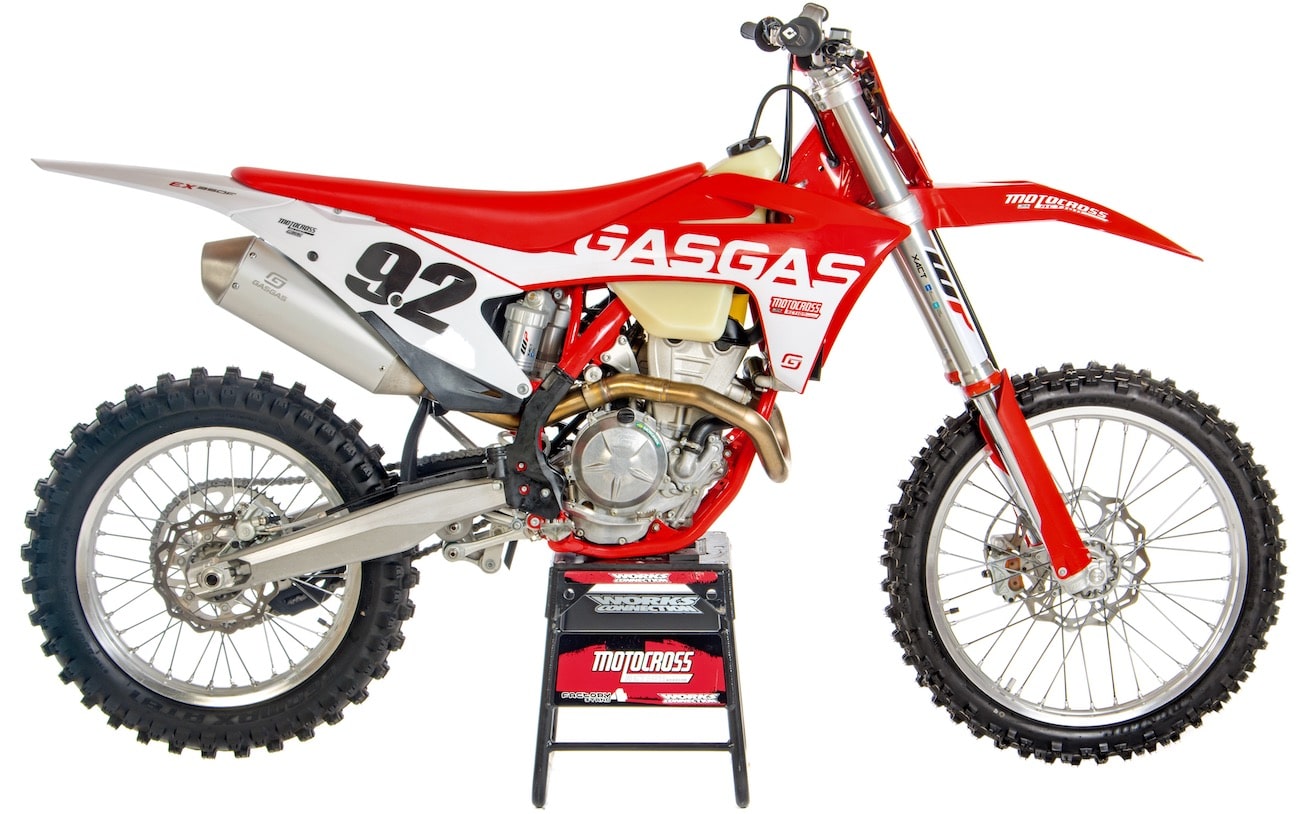 The GasGas off-road models are not completely red like the motocross model, but are red and white.
The GasGas off-road models are not completely red like the motocross model, but are red and white.
Q: WHAT DOESN’T THE GASGAS EX 350F SHARE WITH THE KTM 350XCF?
A: The GasGas EX 350F can’t just copy the KTM 350XCF; it has to have its own unique features. Here is a quick list:
(1) Plastic. All the GasGas plastic is different from the KTM 350XCF plastic, save for the off-road gas tank. And the color palette on the GasGas cross-country models is not solid red like the motocross version but rather red and white
(2) Triple clamps. The GasGas uses forged triple clamps instead of billet KTM clamps. Plus, the GasGas bar mounts are bolted straight to the forged clamps without any rubber buffer in between.
(3) Seat. The seat foam is noticeably softer than that of the KTM seat foam. The shape of the seat is a bit more rounded, and the seat cover material is not very grippy.
(4) Map switch. The GasGas ECU doesn’t have the push-button multi-switch from the KTM that allows you to access Traction Control, Launch Control or Map 2. The stock map in the GasGas is the same map that comes standard as Map 1 on the KTM 350SXF. If you want to access all the maps, you will need to buy the plug-and-play map switch from your local GasGas, KTM or Husky dealer.
(5) Exhaust. The EX 350F doesn’t have the KTM 350XCF’s resonance chamber on the mid-pipe.
(6) Hour meter. The GasGas EX 350F doesn’t come with the triple clamp-mounted hour meter because there is no place to mount it on the slimmer and narrower forged GasGas triple clamps.
(7) Price. The GasGas EX 350F’s retail price is $9999, while the 2021 KTM 350XCF is $700 more expensive at $10,699.
Q: IS THE EX 350F MORE OFF-ROAD OR MORE MOTOCROSS?
A: The three major differences between the GasGas cross-country version and the GasGas motocross version (when its available later this summer) would be the transmission, gas tank and 18-inch rear wheel. Let’s tackle them one at a time.
Six-speed transmission. The wide-ratio gearbox is about perfect for off-road riding, both slower eastern events and wide-open western events. The six gears enable the bike to be ridden up steep rocky trails in first gear and hit quasar speeds in sixth. Compared to the five-speed motocross gearbox, first gear is much lower on the EX than on the motocross model. Second gear is slightly taller, but we found that gear to be very versatile off-road and on-track. Third gear was much taller on the EX than on the comparable five-speed gearbox, which meant that there were situations on a motocross track where you had to clutch the engine to get it to pull third. Fourth was a lot taller, as was fifth, and sixth gear was not usable on a motocross track, but the Bonneville Salt Flats are a possibility.
For motocross use, we were forced to swap out the stock 14/51 (3.643 ratio) for a lower 14/52 (3.714 ratio) or an even lower 13/50 (3.846). The sole goal of the gearing changes was to tighten up the gear ratios to help make third gear more usable.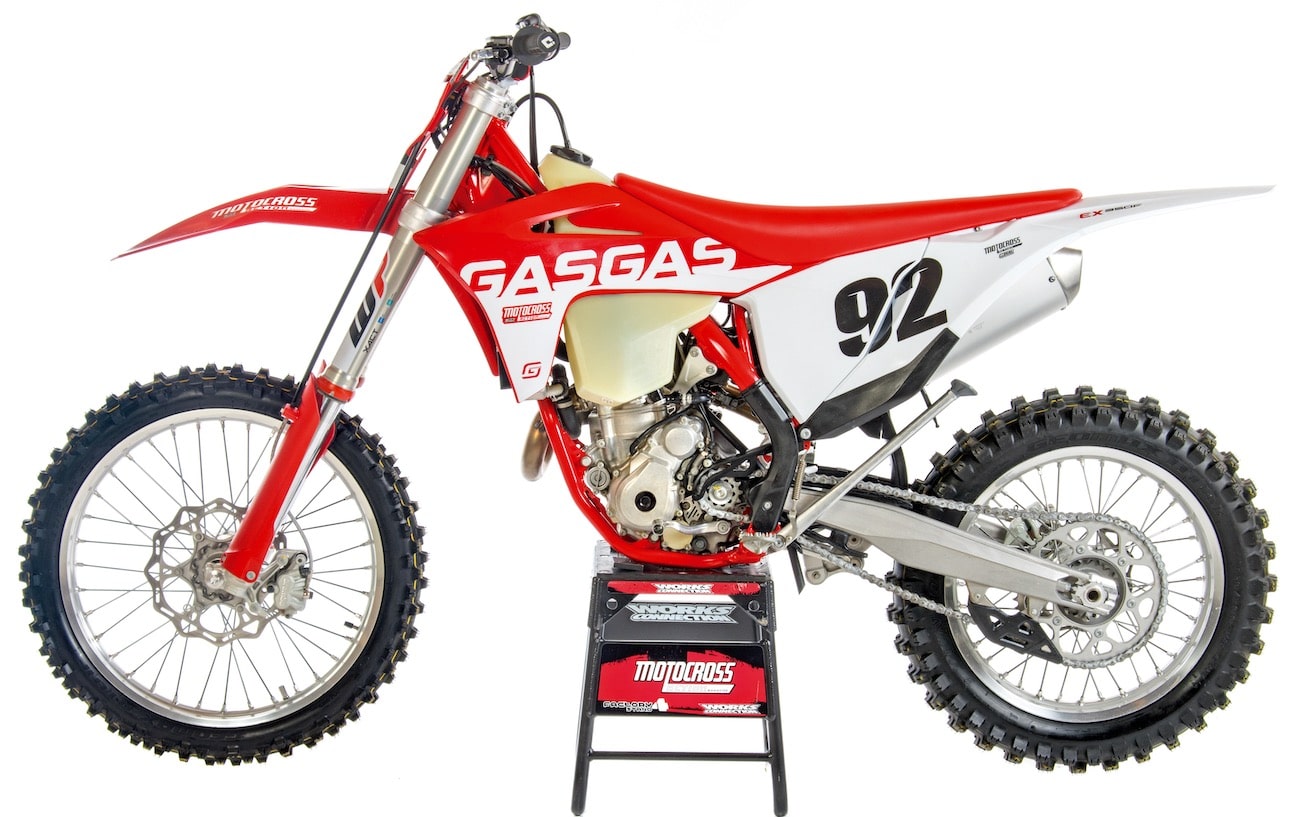
Gas tank. The 2.25-gallon, translucent, off-road gas tank looks bulbous on the left side of the bike, but test riders said that it was easy to get used to and eventually it didn’t bother them. The small 1.8-gallon black motocross tank is sleeker, thinner and nicely shaped. To use the larger off-road tank for motocross, you should mark exactly where 1 gallon is on the milky plastic so that you aren’t carrying 10 extra pounds of fuel to the starting line. By the same token, many Japanese-built cross-country models only have motocross tanks and don’t have enough fuel for long rides.
18-inch rear wheels. The motorcycle industry switched to 19-inch wheels because of Supercross. On the hard, compacted dirt of Supercross, with banked 180-degree turns, the sidewalls of the 18-inch tires of the day would roll over. Additionally, in the cupped faces of whoops, the larger air volume of the 18-inch tires would bounce. For Supercross only, the tire companies designed low sidewall, low-volume tires for the demands of a Supercross track. Of course, once the factory guys started running 19-inch rear wheels, the local riders wanted them also, and the production bikes soon had them. The only riders who didn’t switch were off-road riders, who love the plush feel of the taller sidewalls, larger footprint and added suspension travel of a rear tire that can squish under a load. The MXA test riders like 18-inch tires for most local races, but they only come stock on enduro and cross-country bikes.
Q: WHICH IS FASTER, THE GASGAS EX 350F OR THE KTM 350SXF?
A: We would love to say that there are no differences between the EX 350F powerband and the KTM 350SXF powerband. And, we could justify it by the simple fact that they share all the same engine components, including ECUs, pistons, cams, 44mm Keihin throttle bodies and cylinder heads. The only two exceptions are the non-resonance chamber exhaust pipe and the six-speed gearbox, neither of which hamper the output of the engine since the missing resonance chamber is mostly a sound-deadening device and the six-speed transmission offers more ways to use the existing power while not magnifying or degrading it in anyway.
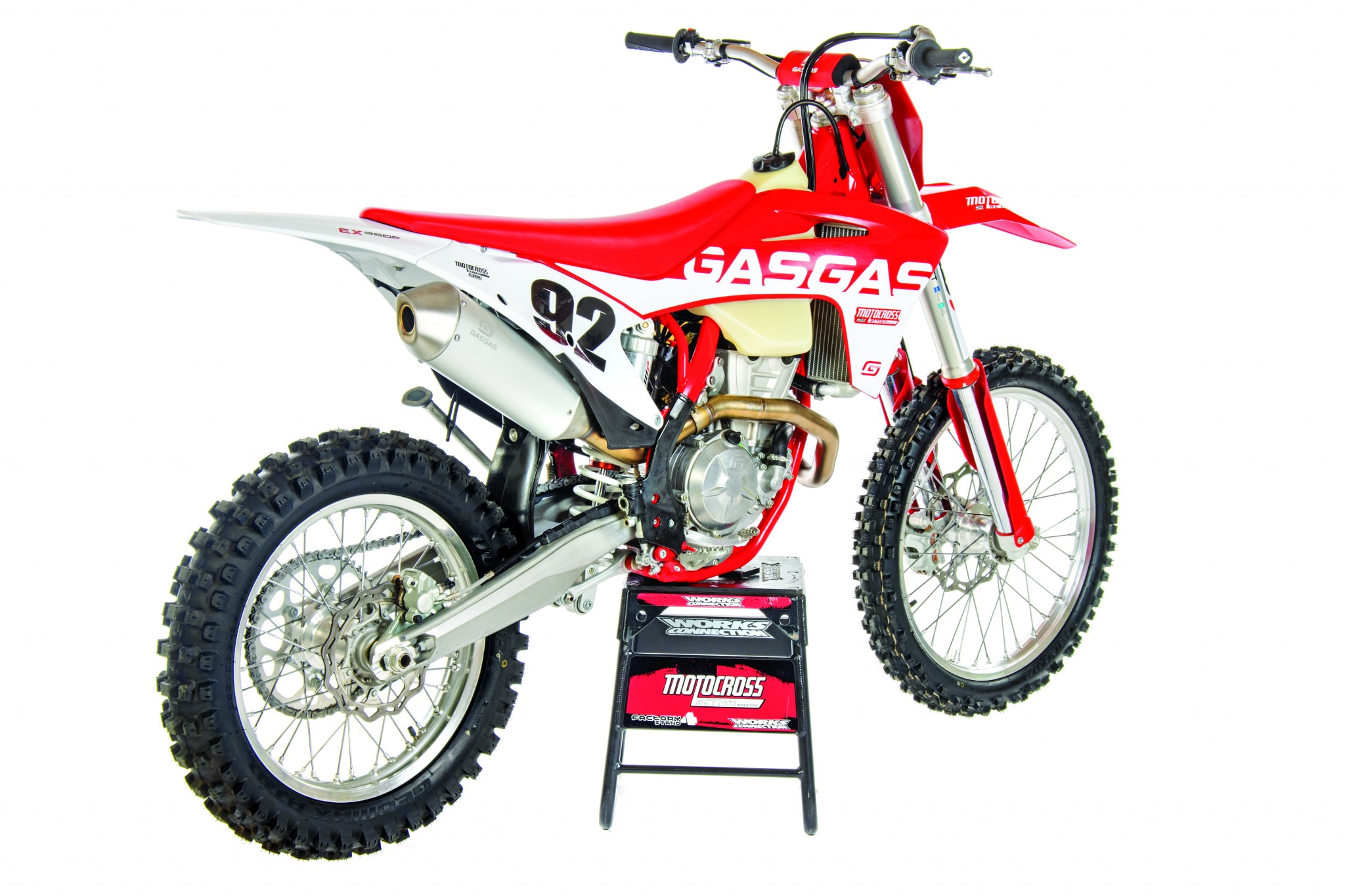
But, the simple fact is that the GasGas EX 350F’s powerband is not as good as the KTM 350SXF’s powerband. But nothing in the engine is to blame. The guilty party is the airbox. After having issues with the EX 350F refusing to pull third gear cleanly out of a tight turn that went up a hill, we put a vented KTM airbox cover on the GasGas and tried the same corner again. Much better! It only needed the slightest touch of the clutch to jump up on the pipe. So, we took the vented airbox cover completely off and went back out, sans airbox cover, and tried the same corner again. Guess what? It pulled third gear like a champ. Do we really need to tell you not to try this sans-airbox test on a racetrack? (It would be okay on a paved road.) The GasGas EX 350F is starved for air. Once it gets abundant air, the throttle response is night-and-day different.
Q: WHAT MAP IS BEST ON THE GASGAS EX 350F?
A: The GasGas EX 350F only comes with one map—and it is the same as Map #1 on the KTM 350SXF. Actually, Map #2, traction control and launch control are embedded in the black box, but GasGas does not include the map switch to access them. They will sell you the plug-and-play switch for $160.
Q: HOW DOES THE 2021 GASGAS EX 350F HANDLE?
A: Every MXA test rider has complained at one point or another about the GasGas MC 450F, MC 250F or EX 350F front-end over-steering into the corners. Initially, we chalked this up to the soft front suspension diving under braking (we tried upping the air pressure), the Maxxis MX-ST tire (we switched to a Dunlop Geomax MX33 to no avail) and the head angle being too steep (we slid the forks down in the triple clamps to kick the head angle out but didn’t like the feel at turn-in). Eventually, our gaze fell upon the 22mm-offset, forged triple clamps. We felt that perhaps the triple-clamp bolts were not torqued to the specs stamped into the KTM triple clamps, but we checked them and they were at the correct 17 N/mm on the top clamp and 12 N/mm on the bottom clamp. That couldn’t be the problem, but then we noticed that the GasGas forged triple clamps did not have torque specs stamped into them. Since we were parked only five Sprinters down from the KTM test department, we walked down there and asked if it were possible that the GasGas triple clamps needed a higher torque setting. Their lead test riders said, “The top triple clamp should be at 20 N/mm.” We scurried back to our pits and reset the top clamp bolts and sent a test rider out to try it. He said it was a lot better. The nice guys in the KTM test department walked up to our pit a few minutes later and said they had checked the GasGas factory torque settings and that they should be 20 N/mm on the top and 15 N/mm on the bottom. Quick like bunnies, we set the lower triple clamp to the proper setting and the oversteer disappeared. Handling problem solved.
Q: WHAT DID WE HATE?
A: The hate list:
(1) Airbox. GasGas needs to offer an optional airbox cover like KTM and Husky so the engine can breathe. The stock one is very restrictive.
(2) Spokes. The spoke by the rim lock comes loose quickly. Watch it closely on day one and every other day after that.
(3) Bleed screws. Please change the fork’s bleed screws from Torx back to the Phillips screws of a few years ago.
(4) Pre-load ring. The plastic pre-load ring needs to be beefed up. It gets chewed up easily.
(5) Fork adjuster. The thin, short fork clicker adjuster hurt our fingers after a few clicks.
(6) Bar pad. The GasGas bar pad is so small that it looks like it came off the GasGas MC 50cc mini.
(7) Front tire. For motocross use, the Dunlop AT-81 tires have limitations, but they are good for off-road riding.
(8) Rebound clickers. Love the hand-operated rebound clickers on the bottom of the fork legs—not the clickers themselves, but the ability to change the rebound by hand.
(9) Quarter-turn gas cap. The Bayonet-style gas cap is not conducive to getting fuel in the tank. You have to press down on a button while turning it, and dirt always clogs up the button. We celebrated when KTM dropped it years ago, but it’s back on the cross-country models.
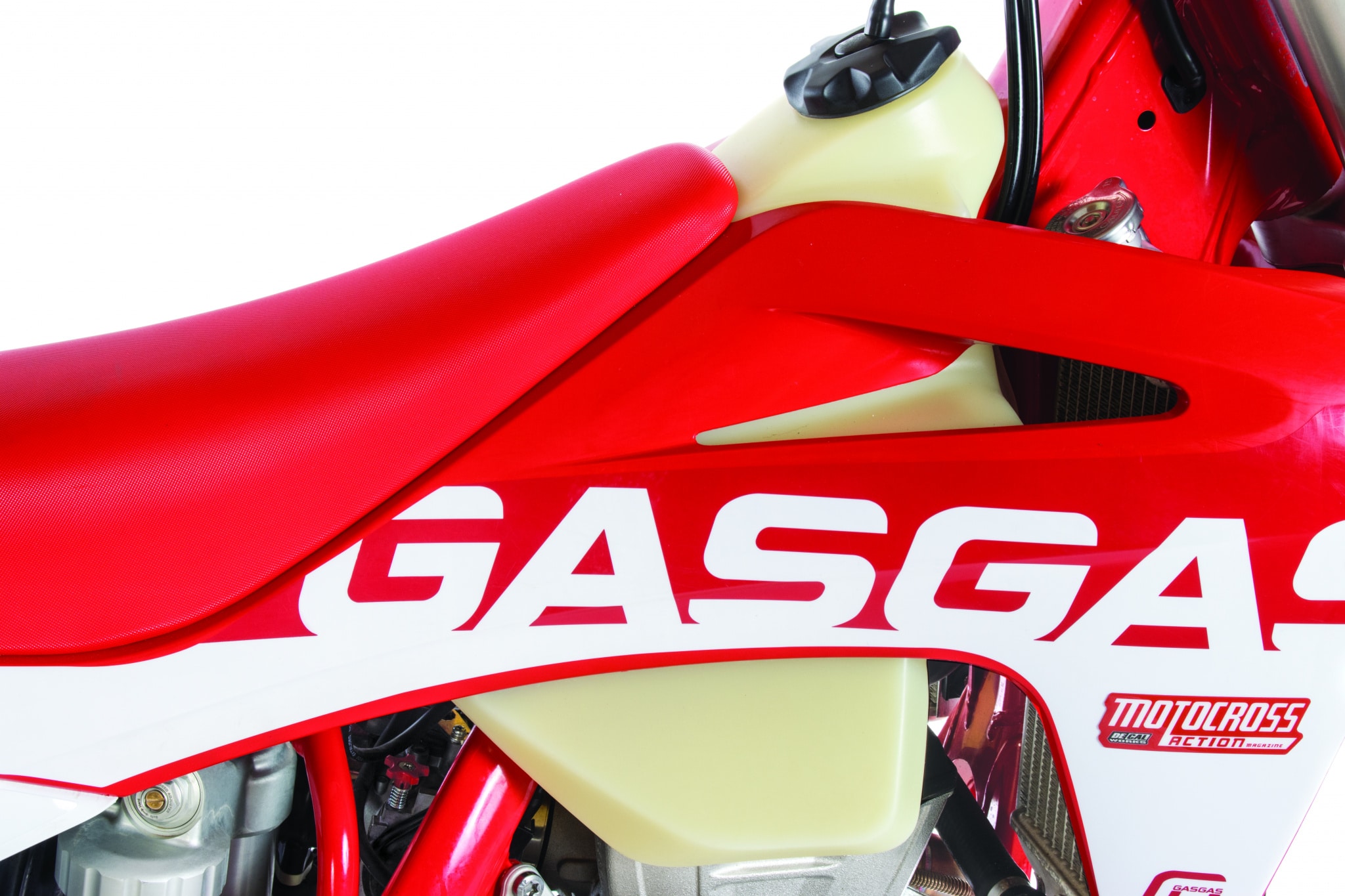
Q: WHAT DID WE LIKE?
A: The like list:
(1) Brakes. The GasGas shares the same Brembo brakes as the KTM 350SXF.
(2) No tools. If you like the KTM no-tools airbox (we do) the GasGas airbox is the same. Best of all, you can run the vented KTM airbox cover on the GasGas. We also cut the winglet off the inside of the GasGas airbox cover to let more air in.
(3) Hydraulic clutch. This DS clutch is bulletproof. From its CNC-machined steel basket (with the primary gear machined into the basket) to its Belleville washer (instead of six separate coil springs) to its self-adjusting Brembo hydraulics, no clutch on the track can take the kind of abuse that this clutch can. This is the dream clutch of every clutch abuser in America.
(4) Power. The 350SXF, FC350 and EX 350F all share the same engine in the class. With the engines being identical on the three bikes, any differences are due to the airbox designs.
(5) Ergonomics. The GasGas EX 350F offers more flex and comfort than the other two Austrian bikes, making it easier to adapt to. Minimal changes are needed to feel comfortable.
(6) Suspension. The only riders who won’t love the suspension setup are fast guys, but even they were impressed with the bottoming capabilities because they rarely bottomed the XACT forks. The off-road-valved forks are more than capable of navigating a motocross track.
(7) Lock-on grips. We like the ease of use of the standard ODI lock-on grips.
(8) Braided-steel brake hose. The GasGas comes stock with minimal expansion PTFE brake hoses with a 64-strand braided steel overlay.
Q: WHAT DO WE REALLY THINK OF THE 2021 GASGAS EX 350F?
A: The MXA test riders wanted a GasGas MC 350F, but they didn’t make one. The next best thing was to get a 2021 GasGas EX 350F and see how it worked, both off-road and on a race track. We have a lot of experience with turning cross-country bikes into motocross bikes, so we know all of the pitfalls. You have to take the limitations in stride: If it had a five-speed transmission, it would be no good at GNCC or WORCS races; if it had a motocross gas tank, you could not go riding in the desert without having to come back to your truck after you got 20 minutes away from it; if it had motocross suspension, the first rocky, tight and twisty single track would bounce your kidneys to death. You gotta give to get—and be prepared to innovate solutions to blend the differences away. We wanted a GasGas 350, and the EX 350F is it.
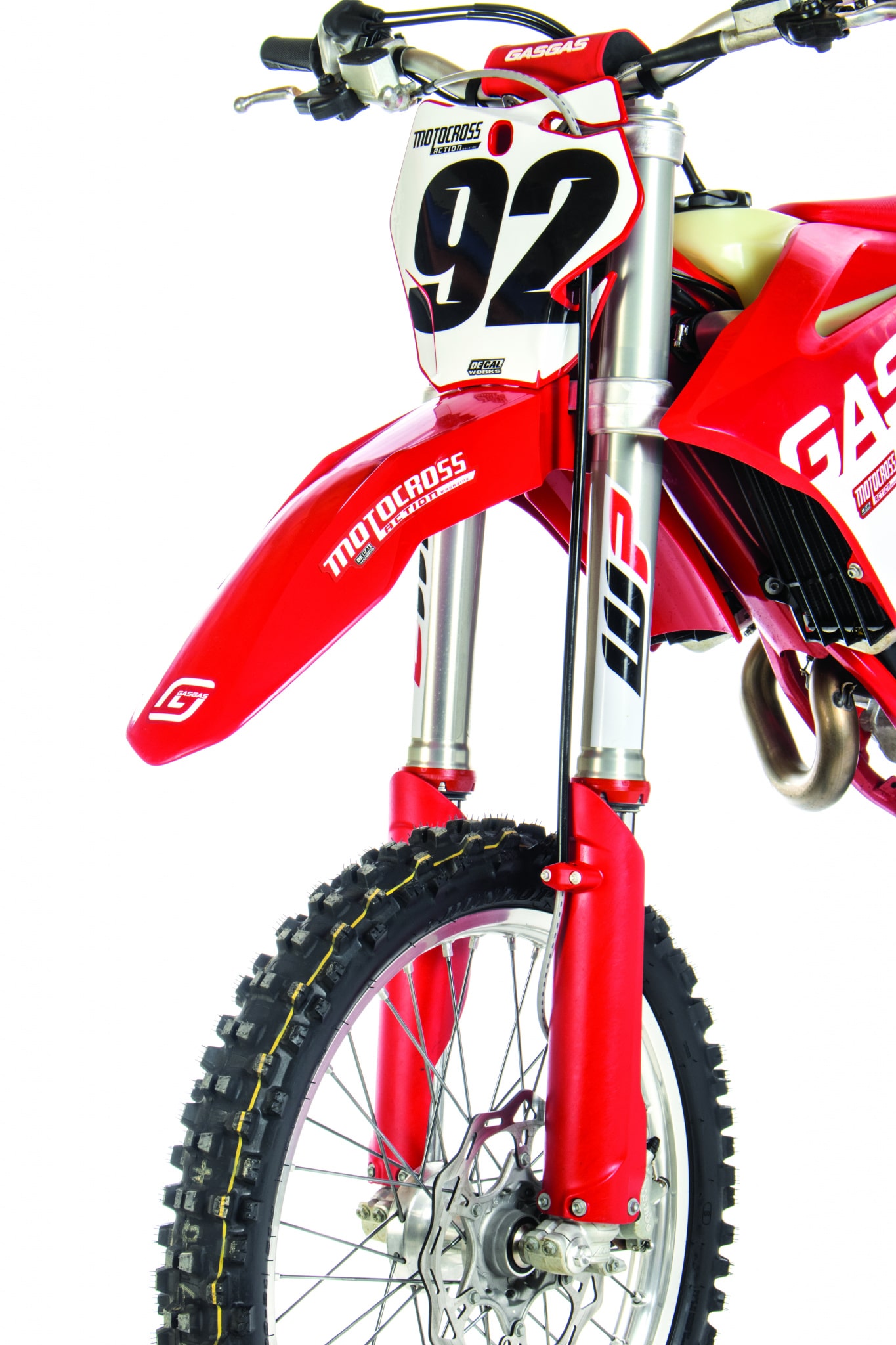
MXA’S 2021 GASGAS EX 350F SETUP SPECS
This is how we set up our 2021 GasGas EX 350F for racing. We offer it as a guide to help you find your own sweet spot.
48MM XACT FORK SETTINGS
In stock trim, the WP XACT forks offer a plush setting that still features excellent bottoming resistance. Most riders didn’t drift far from the stock clicker settings. We even noted that our fastest Pro test riders weren’t using all of the WP fork’s travel. Test riders did notice that the front end suffered from oversteer at times, but after chasing our tails for six hours, we eventually torqued the triple clamp bolts to the correct N/mm. For hardcore racing, we recommend this fork setting for an average rider on the 2021 GasGas EX 350F (stock specs are in parentheses):
Air pressure: 9.8 bar (142 psi)
Compression: 12 clicks out
Rebound: 18 clicks out
Fork-leg height: One and a half lines (Second line)
Notes: Remember to check the air pressure every day that you go out and be sure to bleed those pesky air screws to release built-up, incidental air pressure.
WP SHOCK SETTINGS
This is a good all-around shock. Although we do make clicker adjustments, we rarely stray far from the stock 15 clicks out on compression. It can be dialed in with only a few clicker changes. As a rule of thumb, most MXA test riders leave the low-speed compression on the stock setting and focus on the high-speed dial to make the changes. For hardcore racing, we recommend this shock setup for the 2021 GasGas EX 350F (stock specs are in parentheses):
Spring rate: 42 N/mm
Race sag: 105mm
Hi-compression: 1.5 turns out (2 turns out stock)
Lo-compression: 15 clicks out
Rebound: 15 clicks out
Notes: The stock shock spring has a 42 N/mm rate, which is also the same spring rate as on the GasGas MC 450F; however, on the 450, the shock spring is not firm enough to allow a rider over 185 pounds to get free sag numbers between 30mm and 40mm. If you weigh in the 185-and-up range, switch to the 45 N/mm shock spring.










Comments are closed.